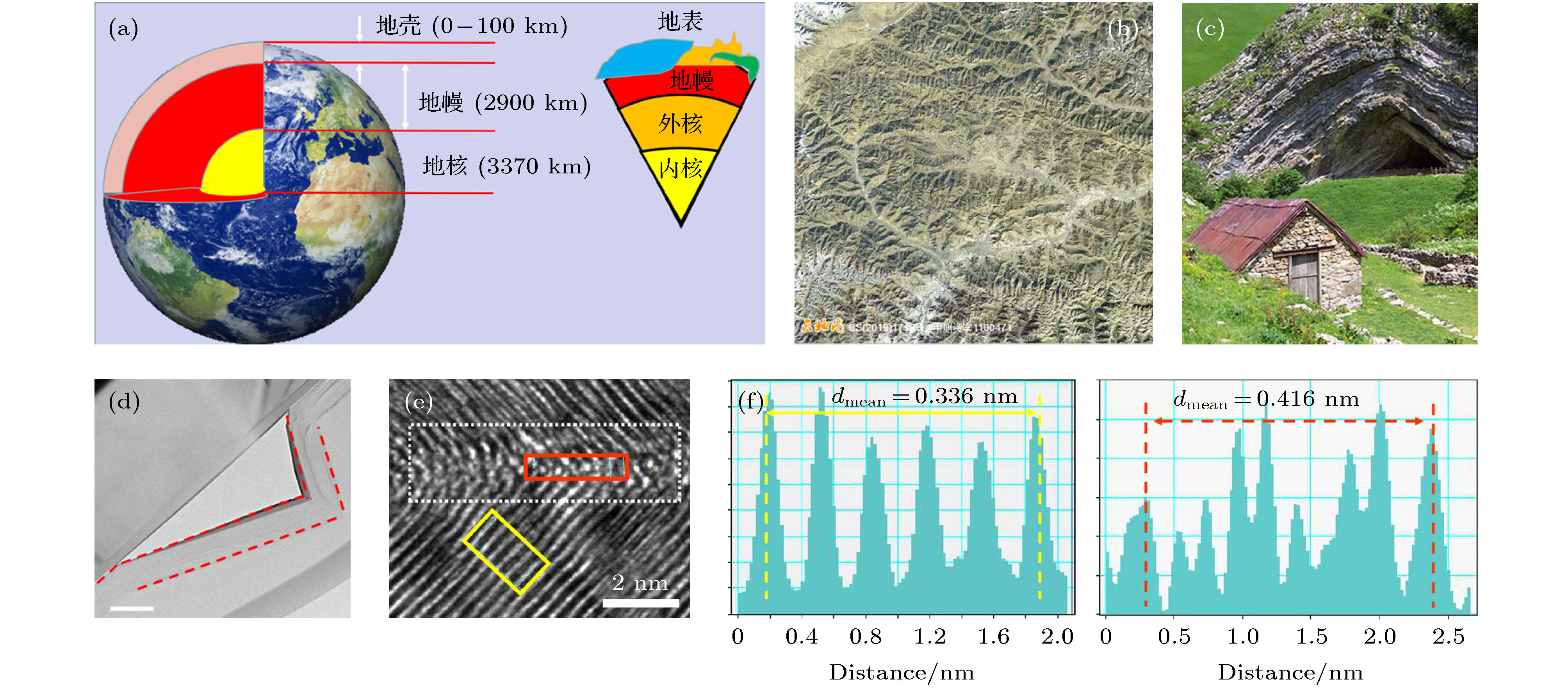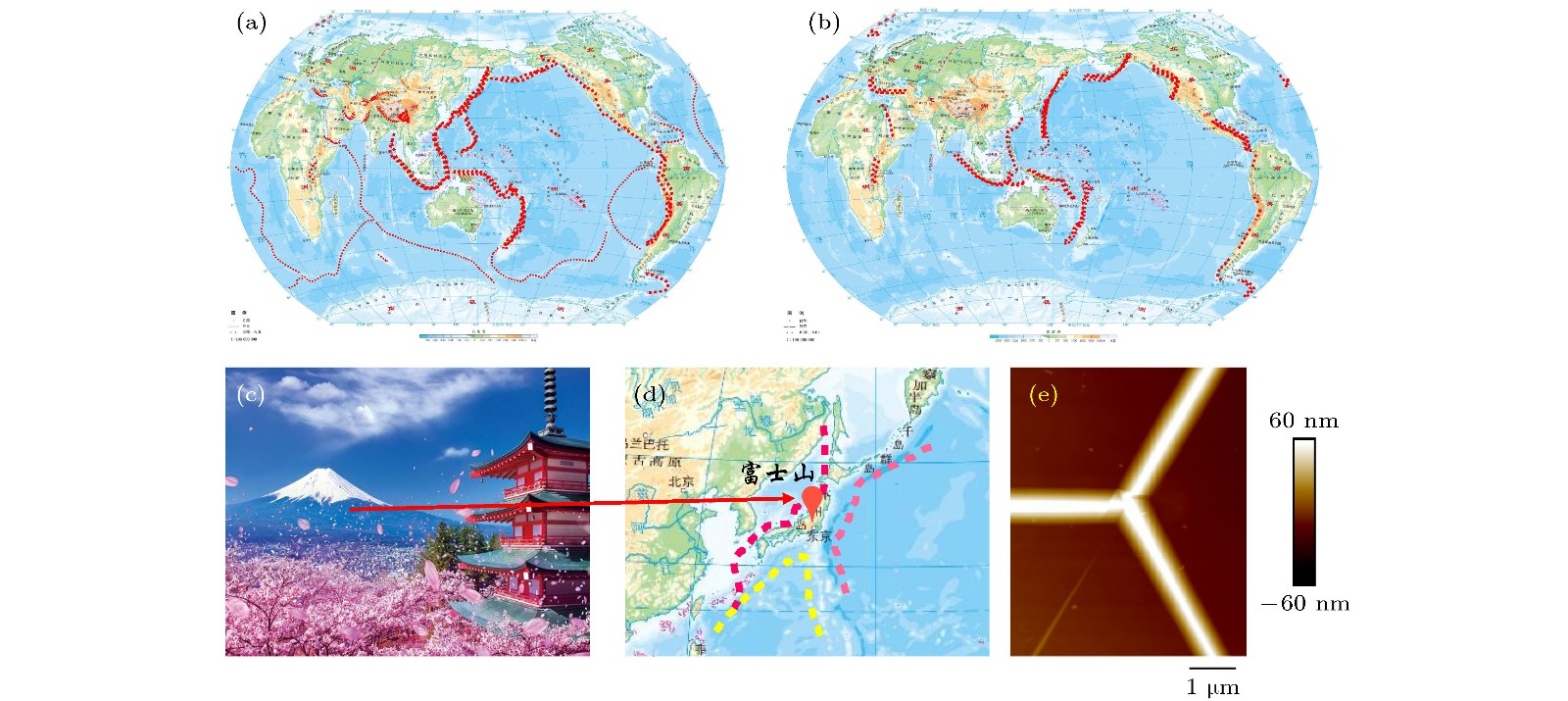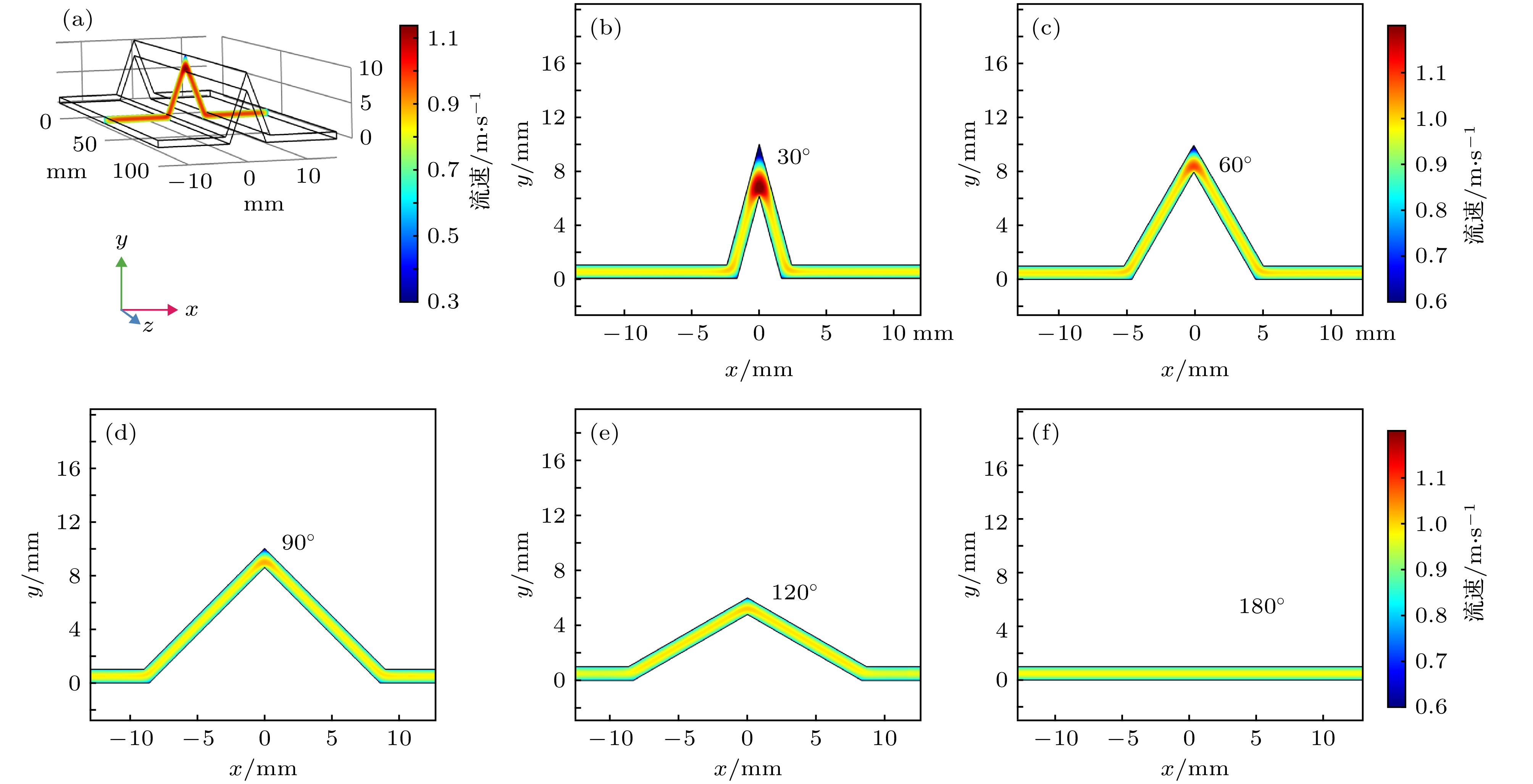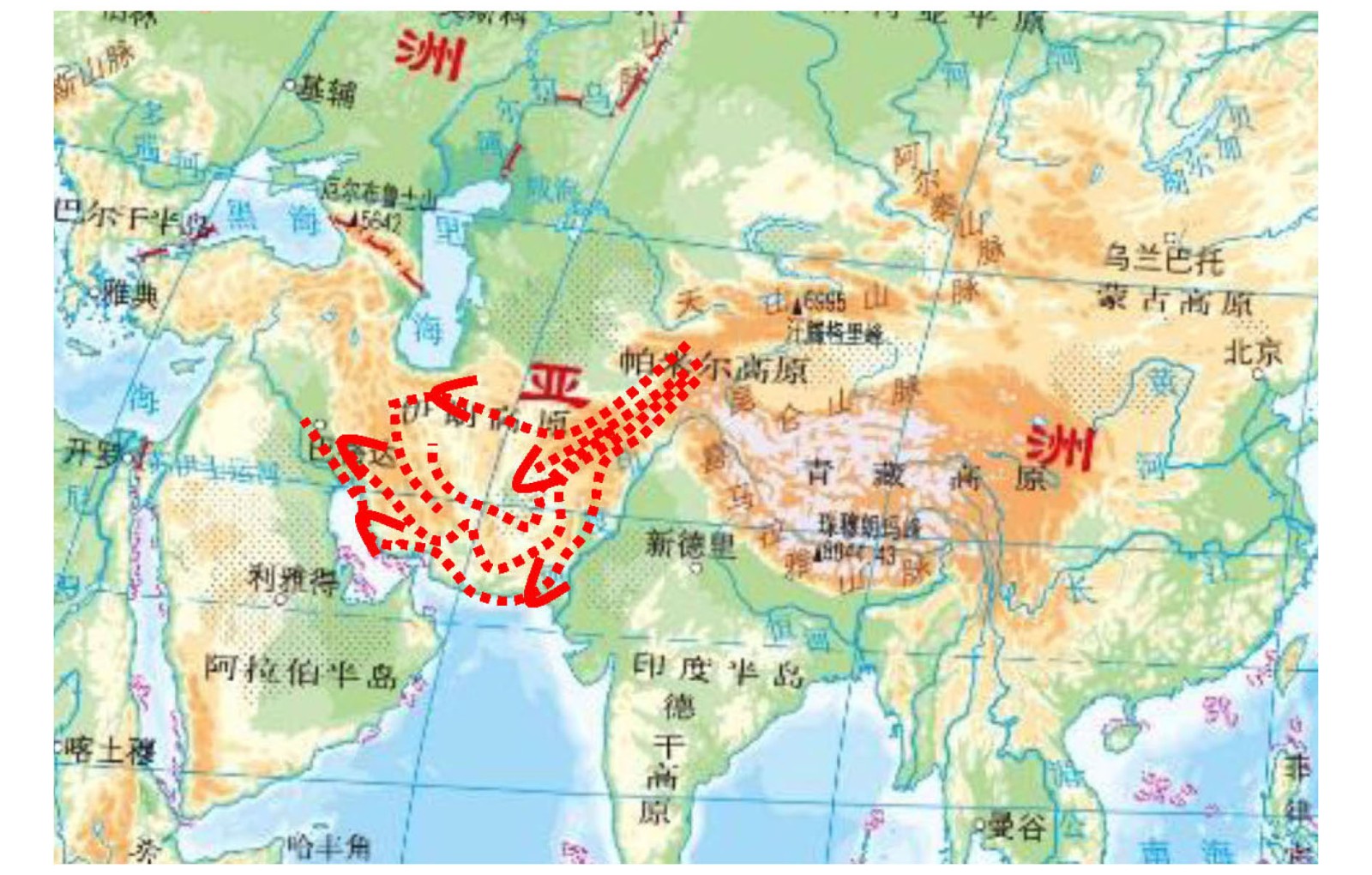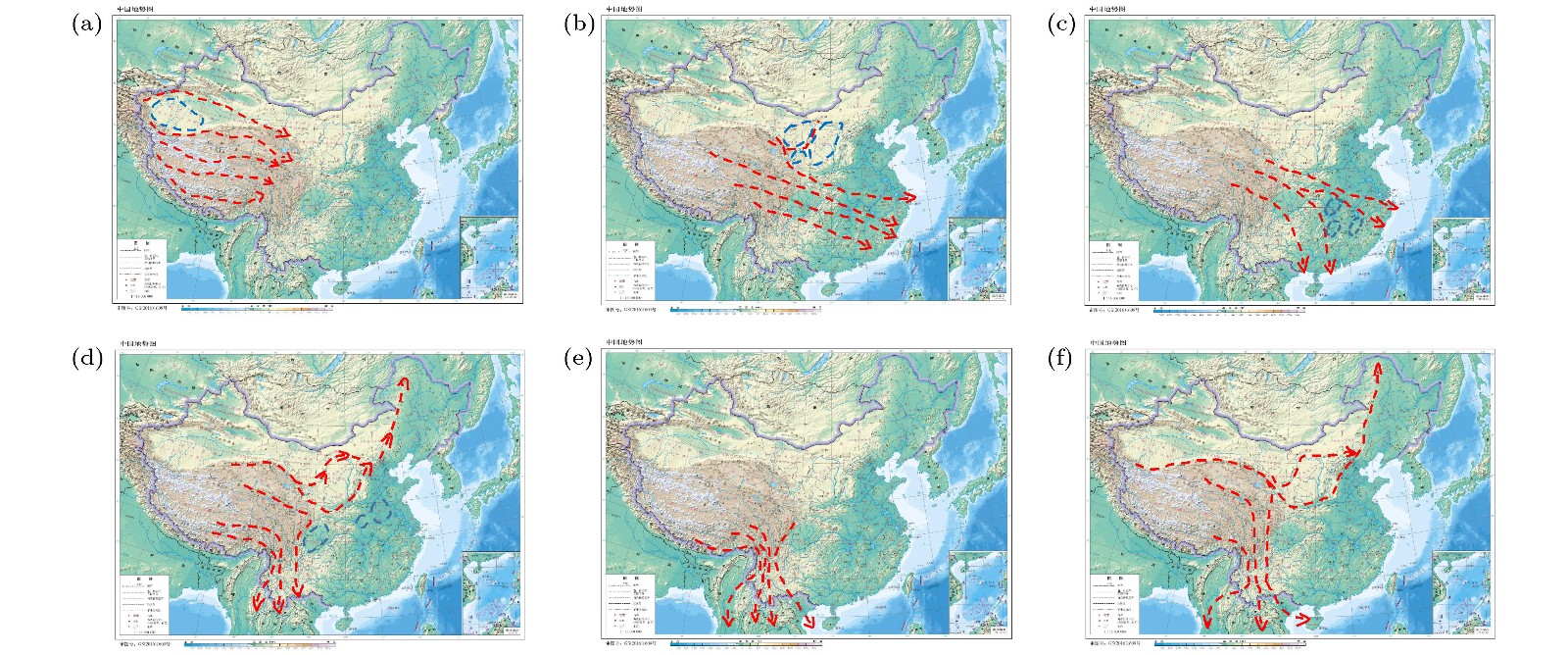-
In this work, we propose a universal method of preparing wrinkle structures in layered crystals, which provides a good model for studying the physical properties of layered materials under strain. More importantly, there are some similarities between wrinkle engineering and geological activities, which inspires us to give some possible explanations to the mechanism for geological activities like earthquake and volcanic. The wrinkle structures of layered crystals can be achieved by exerting uniaxial or biaxial stress on the flexible substrate, which is very similar to the layered structure of the Earth and the formation of mountain folds on the Earth's surface. Since the Earth has an uneven mass distribution and self-rotation as well, the moments of inertia for plates are different from each other. Here in this work, we point out that there is a difference in angular velocity between the north hemisphere and south hemisphere, which may strongly influence the topography and geology activities near the equator. This work provides a possible mechanism explanation for several geological phenomena such as earthquakes, volcanoes, and continental drift. Based on China's special topography, we propose a matter flow hypothesis and discuss the orientation of matter flow in detail. We point out that the geological activity mechanism in China and the regions around plate boundaries is quite different. The matter flow hypothesis can be well applied to explain the causes of earthquake disasters in China, the distribution of mineral resources, and the possible causes of oil in the Middle East countries. Besides, it also provides a new theoretical guidance for predicting the earthquake disasters and prospecting the mineral resources in China. This work provides a new idea for humans to avoid natural disasters, to understand the natural phenomena on the Earth, and to make rational use of natural resources.
-
Keywords:
- layered material /
- wrinkles /
- stress and strain /
- earthquake /
- volcano /
- matter flow
[1] Boddeti N G, Liu X, Long R, Xiao J, Bunch J S, Dunn M L 2013 Nano Lett. 13 6216
 Google Scholar
Google Scholar
[2] Feng J, Qian X F, Huang C W, Li J 2012 Nat. Photonics 6 865
[3] Huang Y, Wang X, Zhang X, et al. 2018 Phys. Rev. Lett. 120 186104
 Google Scholar
Google Scholar
[4] Kim S, Ryu S 2016 Carbon 100 283
 Google Scholar
Google Scholar
[5] Bao Z, Miao F, Chen Z, Zhang H, Jang W Y, Dames C, Lau C N 2009 Nat. Nanotechnology 4 562
 Google Scholar
Google Scholar
[6] Guinea F, Katsnelson M I, Geim A K 2010 Nat. Phys. 6 30
 Google Scholar
Google Scholar
[7] Luo S W, Hao G L, Fan Y P, Kou L Z, He C Y, Qi X, Tang C, Li J, Huang K, Zhong J X 2015 Nanotechnology 26 105705
 Google Scholar
Google Scholar
[8] Huang Y, Sutter E, Shi N N, Zheng J B, Yang T Z, Englund D, Gao H J, Sutter P 2015 ACS Nano 9 10612
 Google Scholar
Google Scholar
[9] 许宏, 孟蕾, 李杨, 杨天中, 鲍丽宏, 刘国东, 赵林, 刘天生, 邢杰, 高鸿钧, 周兴江, 黄元 2018 物理学报 67 218201
 Google Scholar
Google Scholar
Xu H, Meng L, Li Y, Yang T Z, Bao L H, Liu G D, Zhao L, Liu T Y, Xing J, Gao H J, Zhou X J, Huang Y 2018 Acta Phys. Sin. 67 218201
 Google Scholar
Google Scholar
[10] Castellanos-Gomez A, Roldan R, Cappelluti E, Buscema M, Guinea F, van der Zant H S J, Steele G A 2013 Nano Lett. 13 5361
 Google Scholar
Google Scholar
[11] Ni Z H, Yu T, Lu Y H, Wang Y Y, Feng Y P, Shen Z X 2008 ACS Nano 2 2301
 Google Scholar
Google Scholar
[12] Wang Y, Yang R, Shi Z W, Zhang L C, Shi D X, Wang E G, Zhang Y Z 2011 ACS Nano 5 3645
 Google Scholar
Google Scholar
[13] Meng L, Li Y, Liu T S, Zhu C Y, Li Q Y, Chen X J, Zhang S, Zhang X, Bao L H, Huang Y, Xu F, Ruoff R S 2020 Carbon 156 24
 Google Scholar
Google Scholar
[14] 陆坤权, 曹则贤, 厚美瑛, 姜泽辉, 沈容, 王强, 孙刚, 刘寄星 2014 物理学报 63 219101
 Google Scholar
Google Scholar
Lu K Q, Cao Z X, Hou M Y, Jiang Z H, Shen R, Wang Q, Sun G, Liu J X 2014 Acta Phys. Sin. 63 219101
 Google Scholar
Google Scholar
[15] 陆坤权, 厚美瑛, 姜泽辉, 王强, 孙刚, 刘寄星 2012 物理学报 61 119103
 Google Scholar
Google Scholar
Lu K Q, Hou M Y, Jiang Z H, Wang Q, Sun G, Liu J X 2012 Acta Phys. Sin. 61 119103
 Google Scholar
Google Scholar
[16] Scholz C H 1996 Nature 381 556
 Google Scholar
Google Scholar
[17] 李四光 1973 中国科学 4 400
Li S G 1973 Scientia Sinica 4 400
[18] Clark M K, Royden L H 2000 Geology 28 703
 Google Scholar
Google Scholar
[19] Royden L H, Burchfiel B C, King R W, Wang E, Chen Z L, Shen F, Liu Y P 1997 Science 276 788
 Google Scholar
Google Scholar
[20] Hand E 2018 Science 359 16
 Google Scholar
Google Scholar
[21] Webster C R, Mahaffy P R, Atreya S K, et al. 2018 Science 360 1093
 Google Scholar
Google Scholar
[22] Bar-Ona Y M, Phillips R, Milo R 2018 Proc. Natl Acad. Sci. USA 115 6506
 Google Scholar
Google Scholar
[23] 李海兵, 司家亮, 付小方, 邱祝礼, 李宁, Woerd J, 裴军令, 王宗秀, 侯立玮, 吴富峣 2009 第四纪研究 29 387
 Google Scholar
Google Scholar
Li H B, Si J L, Fu X F, Qiu Z L, Li N, Woerd J, Pei J L, Wang Z X, Hou L W, Wu F R 2009 Quat. Sci. 29 387
 Google Scholar
Google Scholar
[24] Wei J, Shen C, Liu S, Dai M 2014 Geodesy and Geodynamicas 5 55
[25] 周玖, 黄修武 1980 地震地质 2 4
Zhou J, Huang X W 1980 Seismol. Geol. 2 4
[26] 周玖 1989 地震研究 12 23
Zhou J 1989 J. Seismol. Res. 12 23
[27] Bai D H, Unsworth M J, Meju M A, et al. 2010 Nat. Geosci. 3 358
 Google Scholar
Google Scholar
[28] Jones L M, Wang B Q, Xu S, Fitch T J 1982 J. Geophys. Res. 87 4575
 Google Scholar
Google Scholar
[29] Mogi K 1987 Tectonophysics 138 33
 Google Scholar
Google Scholar
[30] Wyss M, Wu Z L 2014 Seismol. Res. Lett. 85 126
 Google Scholar
Google Scholar
[31] Lu K Q, Cao Z X, Hou M Y, Jiang Z H, Shen R, Wang Q, Sun G, Liu J X 2018 Int. J. Mod. Phys. B 32 1850080
 Google Scholar
Google Scholar
[32] 张国民, 汪素云, 李丽, 张晓东, 马宏生 2002 科学通报 47 663
 Google Scholar
Google Scholar
Zhang G M, Wang S Y, Li L, Zhang X D, Ma H S 2002 Chin. Sci. Bull. 47 663
 Google Scholar
Google Scholar
[33] Aronova E 2018 Stud. Hist. Philos. Sci. 70 50
 Google Scholar
Google Scholar
[34] King C Y 1983 Nature 302 763
 Google Scholar
Google Scholar
[35] Kirschvink J L 2000 B Seismol. Soc. Am. 90 312
 Google Scholar
Google Scholar
[36] Logan J M 1977 Nature 265 404
 Google Scholar
Google Scholar
[37] Otis L 1984 Am. Sci. 72 81
[38] Tributsch H 1984 MIT Press 115 24
[39] Harnett C 2012 Young Scientists J. 12 60
[40] Woith H, Petersen G M, Hainzl S, Dahm T 2018 Bull. Seismol. Soc. Am. 108 1031
 Google Scholar
Google Scholar
[41] 耿庆国 1984 中国科学 27 658
Geng Q G 1984 Sci. Sin. 27 658
-
图 1 液氮法快速制备层状材料褶皱结构[13] (a)层状材料褶皱的制备过程示意图, 首先将层状材料解理到柔性PDMS基底上, 然后将其快速浸没到液氮中; (b)解理到PDMS上的薄层石墨烯样品光学照片; (c)液氮处理后石墨烯表面形成大量的褶皱网状结构; (d)多层WSe2褶皱的光学照片; (e) WSe2褶皱处的荧光成像(1.6 eV附近), (b)和(c)图的比例尺为50 μm, (d)和(e)的比例尺为5 μm
Figure 1. Preparation of wrinkle structures on layered materials by fast-cooling treatment in liquid nitrogen[13]: (a) Schematic diagram of the preparation process of layered material wrinkles. First, the layered material is cleaved onto the flexible PDMS substrate, then rapidly immersed the substrate in liquid nitrogen; (b) optical images of one thin-layer graphene flake cleaved onto PDMS film; (c) a large number of wrinkle network structures formed on the surface of graphene after liquid nitrogen treatment; (d) optical image of multilayer WSe2 wrinkles; (e) photoluminance mapping image of the multilayer WSe2 flake with wrinkles (at ~1.6 eV). The scale bars are 50 μm for (b) and (c), and 5 μm for (d) and (e).
图 2 地球的结构与材料中的褶皱 (a)地球的结构由内而外可以分为地核、地幔和地壳; (b)念青唐古拉山附近的卫星地图、隆起的山体交错在一起, 形成褶皱的网状结构; (c)山体断面处的褶皱; (d)石墨烯褶皱截面处的TEM照片[13]; (e)高倍下的TEM照片; (f)图(e)中黄色和红色框中的石墨烯层间距, 可以看出形变区域相比于平整区域层间距从0.33 nm增加到0.41 nm
Figure 2. The structure of the Earth and wrinkles in materials: (a) The structure of the Earth can be divided into core, mantle and crust from the inside out; (b) the satellite map near the Nyainqentanglha Mountain, where the uplifted mountains are intertwined to form a wrinkle network structure; (c) wrinkle structures at the cross section of one mountain; (d) transmission electron microscopy (TEM) image at the cross section of one graphene wrinkle[13]; (e) high-resolution images of the wrinkle corner; (f) the lattice spacing at the selected areas marked by yellow and red box in (e), the interlayer distance increased from 0.33 nm at the flat region, to 0.41 nm at the strained region.
图 3 (a)全球地震分布图; (b)全球火山分布图, 可以看出除中国大陆以外, 火山分布和地震分布是吻合的; (c)和(d)日本的富士山地面图片和卫星图片, 从图(d)中可以看出富士山恰好处于三个板块的交汇处; (e)石墨烯褶皱的原子力显微镜照片, 可以看出褶皱的交汇点与地面上火山(c), (d)有相似之处
Figure 3. (a) Global seismic distribution map; (b) global volcanic map. It can be seen that volcanic distribution and seismic distribution are consistent except for mainland China; (c) and (d) are the ground and satellites pictures of Japan's Mount Fuji , it can be seen that Mount Fuji is just at the intersection of three plates (d); (e) atomic force microscopy image of the graphene wrinkle, which is similar to the volcano shown in (c) and (d).
图 4 由于南北半球角速度之间存在差别, 赤道附近地区会出现地形的扭曲 (a)印度尼西亚地区; (b)南北美洲交界处; (c)大西洋中部. 红色虚线表示的是该地区总体的地形走势, 黑色虚线表示赤道
Figure 4. Due to the angular velocity difference between the northern and southern hemispheres, the terrain distortion will occur in the vicinity of the equator: (a) The Indonesian region; (b) the border between North and South America; (c) the central Atlantic Ocean. The red dotted line indicates the overall topographic trend of the region, the black dotted line is the equator.
图 5 中国的地势走势及地震带 针对中国特殊的地形结构, 可以将中国的大型山脉走势用虚线进行表示, 粉色部分是中国主要的地震带分布
Figure 5. China's topographic trend and seismic zone. In view of China's special topographical structure, the orientation of the main mountains can be marked with the dashed lines, and the distribution map of China's seismic belt is marked with the pink color.
图 7 层状材料中的褶皱与地球上的火山 (a)一座正在喷发的火山; (b)石墨烯褶皱在氢气等离子体中处理10 h后的形貌图片[13]; (c) 图7(b)中不同位置(A, B, C三个区域)测得的拉曼光谱, 结果表明在褶皱交汇处石墨烯被完全刻蚀掉, 而在褶皱上被部分刻蚀掉, 在平整区域变化最小, 位于1580和2720 cm–1的G峰和2D峰在平整区域相对较强
Figure 7. The wrinkles in layered material and the volcanoes on the Earth: (a) An erupting volcano; (b) an optical image of graphene wrinkles after 10 hours hydrogen plasma treatment[13]; (c) Raman spectra of graphene measured at different locations (A, B, C) in Fig. 7(b). The Raman spectroscopy results show that the graphene is completely etched away at the intersection of the wrinkles, and partially etched away on the single wrinkles, with the smallest change in the plane region, and the G and 2D peaks (1580 and 2720 cm–1) measured at flat area are relatively strong.
图 9 根据物质流假说提出的中国地形地貌的演变过程 (a)亚欧板块和印度板块撞击后形成了喜马拉雅山脉, 使得中国境内的物质流自西向东移动, 如红色虚线所示, 蓝色虚线代表塔里木盆地; (b)物质流被鄂尔多斯盆地改道朝东南方向流动, 形成了中国东南沿海的特殊地形; (c)两湖盆地, 湘中盆地和南昌盆地形成后, 物质流被进一步改道, 形成多个山脉; (d)四川盆地的形成使得朝东南方向的物质流产生了两个主要分支, 一部分向南流动形成横断山脉, 另一部分在南阳盆地和南华北盆地的影响下朝东北方向流动, 形成了太行山脉和大兴安岭; (e)受四川盆地的影响, 朝南的物质流继续向南流动, 对缅甸、老挝、泰国、越南和马来西亚的地形地貌产生了重要影响; (f)中国目前大陆周边的主要物质流走向示意图
Figure 9. The evolution process of China's topography based on matter flow hypothesis: (a) After the collision of the Asia-Europe plate and the Indian plate, the Himalayas are formed, causing the matter flow in China to move from west to east, as indicated by the yellow dotted line; the red dotted line represents the Tarim Basin; (b) the matter flow is diverted to the southeast by the Ordos Basin, forming a special terrain on the southeast coast of China; (c) after the formation of the two lake basins, the Xiangzhong Basin and the Nanchang Basin, the matter flow is further diverted to form multiple mountain ranges; (d) the formation of the Sichuan Basin caused the matter flow along southeast into two main branches, one of which flows southward to form the Hengduan Mountains, and the other part flows northeastward under the influence of the Nanyang Basin and the South North-China Basin, forming the Taihang Mountains and the Daxinganling Mountains; (e) affected by the Sichuan Basin, the southward matter flow continues to flow southward, which influences the topography of Myanmar, Laos, Thailand, Vietnam, and Malaysia; (f) a schematic diagram of the main current matter flows around China's mainland.
-
[1] Boddeti N G, Liu X, Long R, Xiao J, Bunch J S, Dunn M L 2013 Nano Lett. 13 6216
 Google Scholar
Google Scholar
[2] Feng J, Qian X F, Huang C W, Li J 2012 Nat. Photonics 6 865
[3] Huang Y, Wang X, Zhang X, et al. 2018 Phys. Rev. Lett. 120 186104
 Google Scholar
Google Scholar
[4] Kim S, Ryu S 2016 Carbon 100 283
 Google Scholar
Google Scholar
[5] Bao Z, Miao F, Chen Z, Zhang H, Jang W Y, Dames C, Lau C N 2009 Nat. Nanotechnology 4 562
 Google Scholar
Google Scholar
[6] Guinea F, Katsnelson M I, Geim A K 2010 Nat. Phys. 6 30
 Google Scholar
Google Scholar
[7] Luo S W, Hao G L, Fan Y P, Kou L Z, He C Y, Qi X, Tang C, Li J, Huang K, Zhong J X 2015 Nanotechnology 26 105705
 Google Scholar
Google Scholar
[8] Huang Y, Sutter E, Shi N N, Zheng J B, Yang T Z, Englund D, Gao H J, Sutter P 2015 ACS Nano 9 10612
 Google Scholar
Google Scholar
[9] 许宏, 孟蕾, 李杨, 杨天中, 鲍丽宏, 刘国东, 赵林, 刘天生, 邢杰, 高鸿钧, 周兴江, 黄元 2018 物理学报 67 218201
 Google Scholar
Google Scholar
Xu H, Meng L, Li Y, Yang T Z, Bao L H, Liu G D, Zhao L, Liu T Y, Xing J, Gao H J, Zhou X J, Huang Y 2018 Acta Phys. Sin. 67 218201
 Google Scholar
Google Scholar
[10] Castellanos-Gomez A, Roldan R, Cappelluti E, Buscema M, Guinea F, van der Zant H S J, Steele G A 2013 Nano Lett. 13 5361
 Google Scholar
Google Scholar
[11] Ni Z H, Yu T, Lu Y H, Wang Y Y, Feng Y P, Shen Z X 2008 ACS Nano 2 2301
 Google Scholar
Google Scholar
[12] Wang Y, Yang R, Shi Z W, Zhang L C, Shi D X, Wang E G, Zhang Y Z 2011 ACS Nano 5 3645
 Google Scholar
Google Scholar
[13] Meng L, Li Y, Liu T S, Zhu C Y, Li Q Y, Chen X J, Zhang S, Zhang X, Bao L H, Huang Y, Xu F, Ruoff R S 2020 Carbon 156 24
 Google Scholar
Google Scholar
[14] 陆坤权, 曹则贤, 厚美瑛, 姜泽辉, 沈容, 王强, 孙刚, 刘寄星 2014 物理学报 63 219101
 Google Scholar
Google Scholar
Lu K Q, Cao Z X, Hou M Y, Jiang Z H, Shen R, Wang Q, Sun G, Liu J X 2014 Acta Phys. Sin. 63 219101
 Google Scholar
Google Scholar
[15] 陆坤权, 厚美瑛, 姜泽辉, 王强, 孙刚, 刘寄星 2012 物理学报 61 119103
 Google Scholar
Google Scholar
Lu K Q, Hou M Y, Jiang Z H, Wang Q, Sun G, Liu J X 2012 Acta Phys. Sin. 61 119103
 Google Scholar
Google Scholar
[16] Scholz C H 1996 Nature 381 556
 Google Scholar
Google Scholar
[17] 李四光 1973 中国科学 4 400
Li S G 1973 Scientia Sinica 4 400
[18] Clark M K, Royden L H 2000 Geology 28 703
 Google Scholar
Google Scholar
[19] Royden L H, Burchfiel B C, King R W, Wang E, Chen Z L, Shen F, Liu Y P 1997 Science 276 788
 Google Scholar
Google Scholar
[20] Hand E 2018 Science 359 16
 Google Scholar
Google Scholar
[21] Webster C R, Mahaffy P R, Atreya S K, et al. 2018 Science 360 1093
 Google Scholar
Google Scholar
[22] Bar-Ona Y M, Phillips R, Milo R 2018 Proc. Natl Acad. Sci. USA 115 6506
 Google Scholar
Google Scholar
[23] 李海兵, 司家亮, 付小方, 邱祝礼, 李宁, Woerd J, 裴军令, 王宗秀, 侯立玮, 吴富峣 2009 第四纪研究 29 387
 Google Scholar
Google Scholar
Li H B, Si J L, Fu X F, Qiu Z L, Li N, Woerd J, Pei J L, Wang Z X, Hou L W, Wu F R 2009 Quat. Sci. 29 387
 Google Scholar
Google Scholar
[24] Wei J, Shen C, Liu S, Dai M 2014 Geodesy and Geodynamicas 5 55
[25] 周玖, 黄修武 1980 地震地质 2 4
Zhou J, Huang X W 1980 Seismol. Geol. 2 4
[26] 周玖 1989 地震研究 12 23
Zhou J 1989 J. Seismol. Res. 12 23
[27] Bai D H, Unsworth M J, Meju M A, et al. 2010 Nat. Geosci. 3 358
 Google Scholar
Google Scholar
[28] Jones L M, Wang B Q, Xu S, Fitch T J 1982 J. Geophys. Res. 87 4575
 Google Scholar
Google Scholar
[29] Mogi K 1987 Tectonophysics 138 33
 Google Scholar
Google Scholar
[30] Wyss M, Wu Z L 2014 Seismol. Res. Lett. 85 126
 Google Scholar
Google Scholar
[31] Lu K Q, Cao Z X, Hou M Y, Jiang Z H, Shen R, Wang Q, Sun G, Liu J X 2018 Int. J. Mod. Phys. B 32 1850080
 Google Scholar
Google Scholar
[32] 张国民, 汪素云, 李丽, 张晓东, 马宏生 2002 科学通报 47 663
 Google Scholar
Google Scholar
Zhang G M, Wang S Y, Li L, Zhang X D, Ma H S 2002 Chin. Sci. Bull. 47 663
 Google Scholar
Google Scholar
[33] Aronova E 2018 Stud. Hist. Philos. Sci. 70 50
 Google Scholar
Google Scholar
[34] King C Y 1983 Nature 302 763
 Google Scholar
Google Scholar
[35] Kirschvink J L 2000 B Seismol. Soc. Am. 90 312
 Google Scholar
Google Scholar
[36] Logan J M 1977 Nature 265 404
 Google Scholar
Google Scholar
[37] Otis L 1984 Am. Sci. 72 81
[38] Tributsch H 1984 MIT Press 115 24
[39] Harnett C 2012 Young Scientists J. 12 60
[40] Woith H, Petersen G M, Hainzl S, Dahm T 2018 Bull. Seismol. Soc. Am. 108 1031
 Google Scholar
Google Scholar
[41] 耿庆国 1984 中国科学 27 658
Geng Q G 1984 Sci. Sin. 27 658
Catalog
Metrics
- Abstract views: 16003
- PDF Downloads: 185
- Cited By: 0














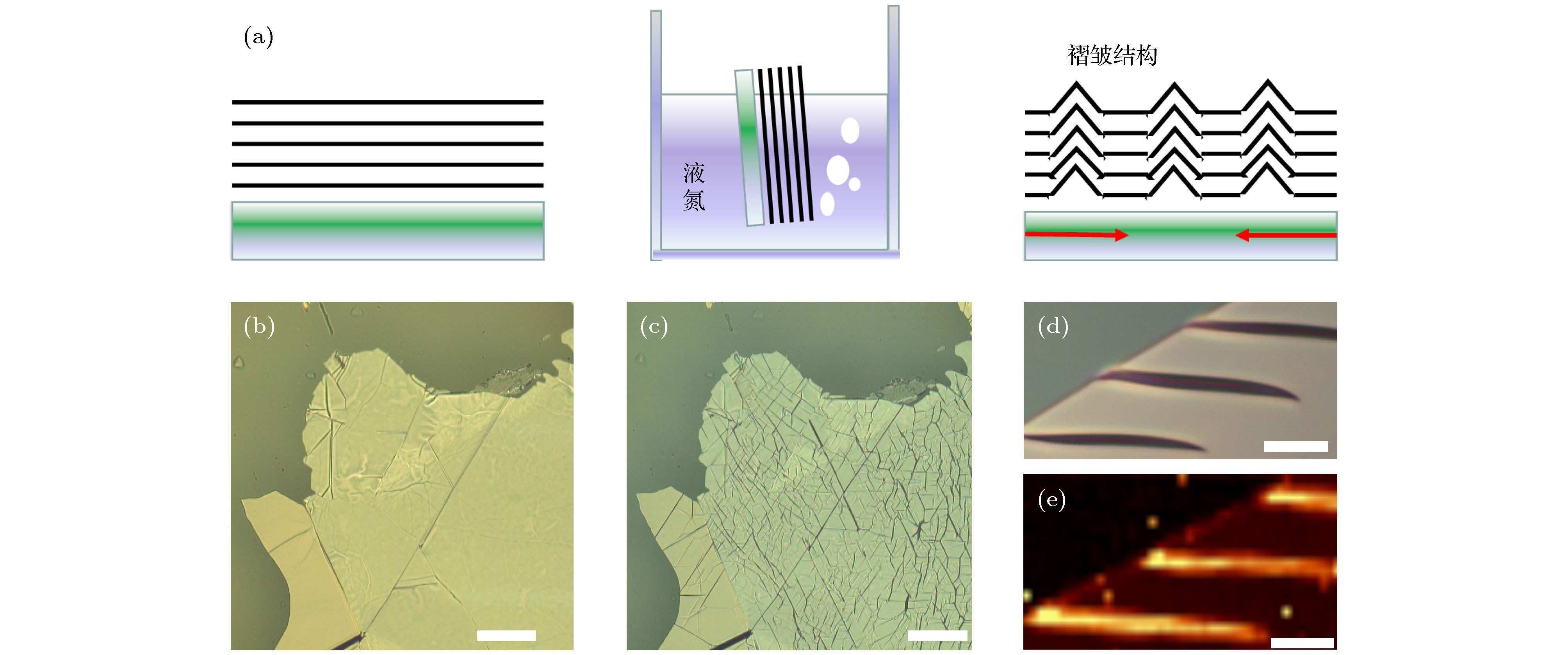
 DownLoad:
DownLoad:
